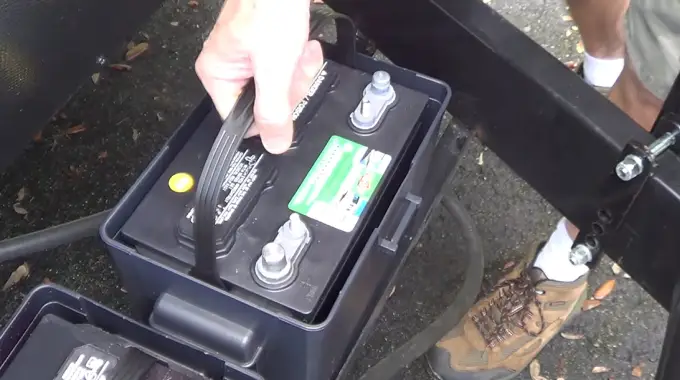Last Updated on May 4, 2023
If you’re an RV-er, then it’s no surprise that a dead battery can ruin your entire trip. But why not beat the odds? Adding a second battery to your rig means never missing out on those exciting adventures. Keep all of your devices and appliances running smoothly so nothing stands in the way of your journey.
By selecting the right location for the battery, connecting it in parallel or series, and securing it in place, you can make sure that your RV is always powered up and ready for your next adventure.
This guide will walk you through the process of adding an extra battery to your RV, so you can hit the road with confidence and travel worry-free. So strap in and get ready to take your RV experience to the next level.
How to Add A Second Battery to An RV: 3 Detailed Steps
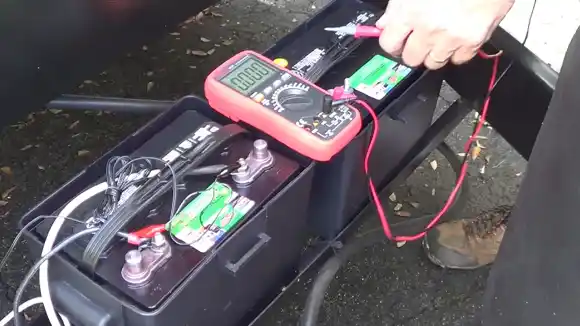
By attaching two batteries to your RV, you can improve your power supply, extend your boondocking period, and have a backup power source. Before installing a second battery, it’s important to determine the electrical needs of your RV and choose the right type of battery.
To install a second battery in your RV, follow these steps:
Selecting a Location for the Battery
Whenever mounting a second RV battery, finding the right spot is crucial. You want to choose a spot that is easily accessible for maintenance and won’t interfere with any other components of your RV.
One popular location for a second battery is in the front compartment of the RV, near the existing battery. This makes it easy to wire the batteries in parallel or series and can provide a balanced weight distribution. However, you may need to consider other options if you have limited space in this compartment.
Another option is to install the second battery under one of the seats inside your RV. This can be a good choice if you have limited exterior storage space and want to keep your batteries out of sight. Be sure to choose a seat that has enough clearance for the battery and allows for proper ventilation.
You may also consider mounting the second battery on the rear bumper or underneath your RV. While this can provide extra storage space, it can also create imbalanced weight distribution and expose your batteries to potential damage from road debris.
Connect Second Battery in Parallel or Series
When mounting a second battery to your RV, one of the key decisions you’ll need to make is whether to connect the batteries in parallel or in series. Each wiring option has advantages and disadvantages, so it’s important to understand what each entails before deciding.
Wiring the batteries in parallel means that the positive terminals are connected together and the negative terminals are connected together. With this configuration, your battery bank has a more amp-hour capacity and a constant voltage output.
Basically, you’ll have more power for longer periods without sacrificing voltage.
On the other hand, wiring the batteries in series means that one battery’s positive terminal is connected to another battery’s negative terminal. This configuration increases the overall voltage output while keeping the amp-hour capacity constant.
In essence, you’ll have higher voltage for shorter periods of time.
So which wiring option should you choose? It depends on your specific needs and preferences. Adding batteries in parallel may be a better choice if you want a better power supply and longer boondocking times.
Securing the Battery in Place
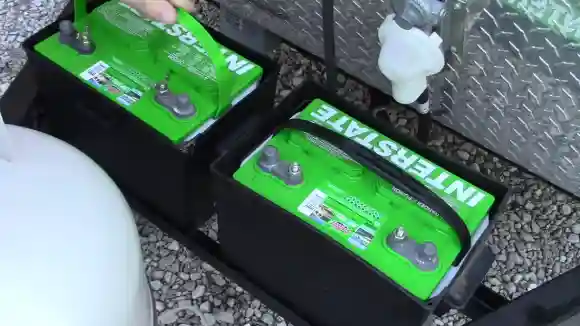
When adding another battery to your RV, securing the battery in place is an essential step. A poorly secured battery can shift during travel and cause damage to itself and other components of your RV.
To secure the battery, you will need some basic tools such as a drill, screws, and brackets. The first step is to select a location for the battery that is secure and easily accessible for maintenance. Choosing a spot away from moving parts or heat sources is important.
Once you have chosen a location, you must install the brackets to hold the battery in place securely. You can either use pre-made brackets or create custom ones based on your specific needs. Make sure to attach the brackets firmly using screws or bolts.
After installing the brackets, you can then place the battery onto them and secure it using additional straps or bungee cords. This will prevent movement during travel and ensure the battery stays in place.
Reasons Why an RV Should Have a Second Battery
Adding a second battery to an RV can be a game-changer for your camping experience. Here are some reasons why you should consider it:
#ONE: Improved Power Supply
With two batteries, you’ll have peace of mind knowing that your RV is powered up and ready to go. Enough juice for all the appliances and electronics makes extended trips stress-free.
When you’re running your air conditioner on a hot day and also charging your phone or laptop, a second battery gives you that extra power you need. Also, a second battery can ensure no interruptions if you have multiple people watching TV at the same time and cooking dinner simultaneously.
#TWO: Longer Boondocking Periods
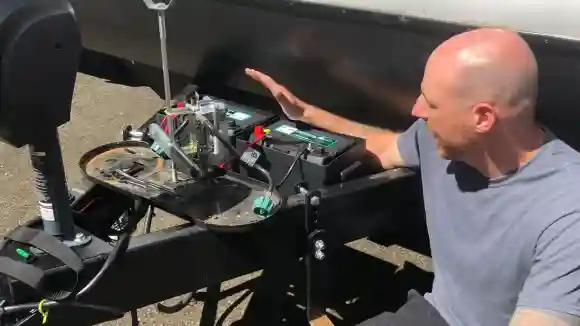
Boondocking, also known as dry camping, is a popular activity among RVers who want to explore remote areas without the amenities of a traditional campground. Boondocking does require careful planning and preparation, especially when it comes to power.
Add a second battery to your RV and you can boondock for longer.
Second batteries also allow you to run appliances and electronics without needing to recharge for longer periods of time. Because of this, you don’t have to worry about running out of power.
#THREE: Enhanced Convenience
The addition of second batteries to RVs enhanced their convenience. You don’t have to worry about conserving power as much and can use electrical devices more freely. A backup battery also serves as an emergency contingency plan, ensuring you can always stay connected and powered up.
A second battery is especially useful for RVs and other mobile homes where power is essential for daily activities.
The Types of Second Batteries Used In RVs
For RV owners, power and battery selection is paramount for keeping your rig running smoothly. Depending on the application, there are several types of batteries to choose from, each with its own distinctive traits.
#1: Flooded Lead-Acid Batteries
Flooded lead-acid batteries are popular for RV owners who want to add a second battery to their rig. These batteries have been around for over a century and are known for their reliability and durability.
Lead-acid batteries are great options if you’re looking for an inexpensive power source that’s easy to find. Whether it’s your local auto parts store or favorite online retailer, these go-tos will have the necessary supplies.
#2: Absorbed Glass Mat (AGM) Batteries
AGM batteries are also a popular choice for RVs. They have been designed to withstand rough terrain and all sorts of conditions while also being maintenance-free. Plus, they’re super safe – you won’t need to worry about spills or other hazards when using them.
These batteries use a special type of glass mat separator that absorbs the electrolyte solution, which means there is no free-flowing liquid inside the battery. Because of this design, they’re more resistant to vibration and shock, making them perfect for RVs.
#3: Lithium-Ion (Li-ion) Batteries
Lithium-Ion (Li-ion) batteries are becoming increasingly popular among RV enthusiasts due to their high energy density, low weight, and long lifespan. Li-ion batteries can hold more power than traditional lead-acid batteries of the same size and weight, so they’re great for adding a backup battery to your RV.
With Li-ion batteries, you’re not stuck worrying about replacement quite so often. These little powerhouses can last a full decade with the right care that’s double or triple what other battery types provide.
What to Consider When Choosing the Right Second Battery for Your RV?
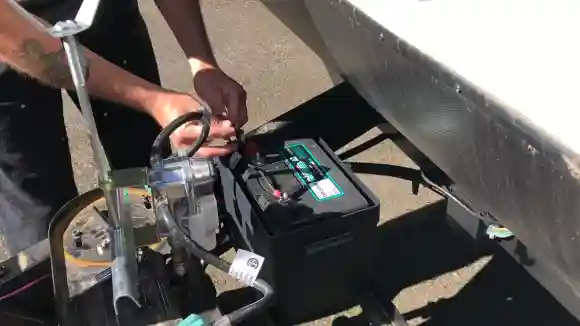
With your RV, know that picking the perfect second battery isn’t an easy task. Weighing up size and capacity to cost and kind requires a lot of thought, but choose right, you can ensure all future power needs are taken care of.
Consider these factors when making your decision:
ONE: Matching Voltage Requirements
When adding more batteries to your RV, it’s crucial to ensure that both batteries have the same voltage requirements. This means that if your current battery is 12 volts, you should choose a second battery with the same voltage rating.
If the two batteries have different voltage ratings, it can cause an imbalance in the electrical system of your RV. This can damage your appliances and electronics or even cause a fire.
Matching the voltage requirements of both batteries also ensures that they charge and discharge at the same rate. If one battery has a higher voltage rating than the other, it will charge faster and discharge slower, which can also lead to damage.
You should check your RV’s owner manual or consult a professional before buying a second battery.
TWO: Capacity and Reserve Capacity
When choosing a second battery for your RV, capacity and reserve capacity are important factors to consider. Capacity refers to the amount of energy the battery can store. In contrast, reserve capacity is the number of minutes a battery can deliver a sustained charge before dropping below a specific voltage level.
You need to calculate your power consumption needs to determine the appropriate capacity for your RV. This involves identifying all the appliances and electronics in your RV and their power requirements.
Think about your heating, cooling, lighting, water pumps, charging devices, and anything else you use regularly.
Once you have calculated your power consumption needs, you can choose a second battery with enough capacity to meet those needs. Remember that adding a second battery does not double your capacity; it only increases it by the new battery’s capacity.
THREE: Physical Size and Weight
Physical size and weight are important factors in adding a battery to your RV. Your RV’s available space and weight capacity will determine which type of battery you can install.
Flooded lead-acid batteries are the heaviest and largest option, requiring a lot of space and weighing up to 70 pounds each. Absorbed Glass Mat (AGM) batteries are more compact and weigh less than flooded lead-acid batteries but are still heavier than lithium-ion (Li-ion) batteries.
Li-ion batteries are the lightest and most compact option, making them ideal for smaller RVs or those with limited storage space.
FOUR: Maintenance Needs
Choosing an extra battery for an RV, it’s important to consider the maintenance needs of each type of battery. Different types of batteries require different levels of maintenance to keep them functioning properly.
Flooded lead-acid batteries are the most common type of battery used in RVs and require regular maintenance. You will need to check the water levels in the battery regularly and add distilled water as needed. It’s also important to regularly clean the terminals and connections to prevent corrosion.
AGM batteries are sealed and require less maintenance than flooded lead-acid batteries. They don’t require watering, but you should still check the terminals and connections periodically for signs of corrosion.
Lithium-ion batteries have the lowest maintenance needs of all three types. They don’t require any watering or terminal cleaning, but you should monitor their performance regularly to ensure they function correctly.
Tips for Maintaining Your RV’s Dual-Battery System
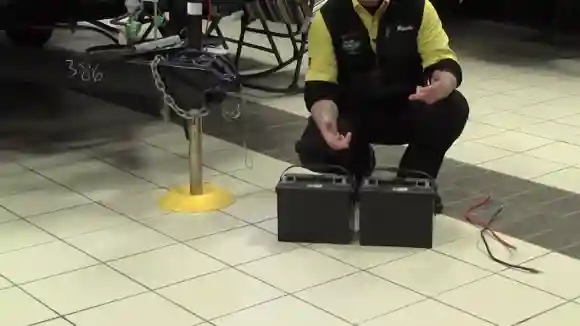
If you’re an RV-er, your dual battery system is key to keeping life on the road running smoothly. Follow these tips for optimal performance and maximum efficiency.
Regularly Checking and Maintaining Batteries
One of the most important things you can do to maintain your batteries is to check their condition regularly. This includes inspecting the terminals and connections for corrosion or damage and cleaning them if necessary. Corrosion can cause poor electrical contact, which can reduce battery performance.
Regularly giving your batteries the multimeter or voltmeter test helps keep you in the knowledge of their charge level. Monitoring performance like this will ensure they’re always ready for action and help avoid surprises.
Cleaning Terminals and Connections
To ensure that your RV’s dual-battery system functions efficiently, checking and maintaining the batteries regularly is crucial. One important aspect of maintenance is cleaning the terminals and connections.
Over time, battery terminals can accumulate corrosion, which can impede the flow of electricity between the battery and other electrical components. To clean the terminals, disconnect the negative cable from each battery. Use a wire brush or a terminal cleaner to clean the terminals and cable ends.
It’s essential to wear gloves and eye protection when doing this, as battery acid can be harmful.
After cleaning, apply a thin layer of petroleum jelly or terminal protector spray to each terminal to prevent future corrosion. Don’t forget to reconnect the negative cables to each battery.
Monitoring Water Levels (Flooded Lead-Acid Only)
Regularly Checking and Maintaining Batteries is an essential part of owning an RV with a dual-battery system, especially if you have Flooded Lead-Acid batteries. Water levels are among the most important things to monitor in these types of batteries.
Flooded Lead-Acid batteries require distilled water to maintain their electrolyte levels. As the battery discharges, the water in the electrolyte solution evaporates, so it’s crucial to check the water levels regularly and top them off as needed. A low water level can damage the battery plates and shorten their lifespan.
To check your battery’s water levels, you’ll need to remove the caps on each cell (usually six cells per battery) and look inside. The water level should be above the top of each plate but below the bottom of the cell cap. If any cells are low on water, add distilled water until they reach the proper level.
Is a Second Battery Enough to Run Your RV Air Conditioner?
If you’re an RV owner planning a summer road trip, you may wonder if running your air conditioner on batteries is possible. Well, the good news is, it is possible. However, a single battery may not be sufficient to power the unit for an extended period.
Installing a second high-capacity lithium battery and an inverter that can convert DC battery power into AC power is recommended for optimal performance. Lithium batteries, in particular, are a great choice as they offer a longer lifespan and faster charging time than traditional lead-acid batteries.
With the added capacity of a second battery, you can extend your run time and charge one battery while using the other to ensure a consistent power supply. Don’t let the summer heat keep you from hitting the road in your RV. With the right setup, you can stay cool anywhere.
Is It Possible to Charge Your RV’S Dual Batteries With Solar Panels?
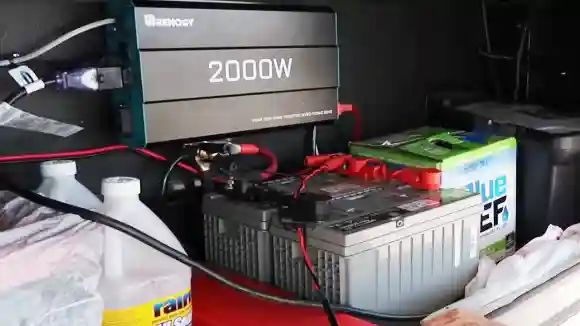
Solar energy is an eco-friendly and renewable way to power your RV batteries. All you need are a few panels, but before connecting these, you must know the kind of battery setup you have. Once set up correctly, though, this could be an easy solution for all your on-the-road charging needs.
If your RV has dual batteries, it is considered a parallel battery bank, where both batteries are connected in parallel to increase the overall system’s capacity. When it comes to charging the battery bank, it is crucial to connect the RV’s house battery bank to the first battery position.
Doing this gives the first battery a full charge before the second one.
You will need a solar panel regulator or controller to connect your solar panel to your RV’s dual batteries. It manages the flow of electricity from the solar panel to the battery bank, preventing overcharging. Put the solar panel leads on the controller, then the battery bank on the output.
Enjoy Limitless Power With a Second Battery for Your RV
If you’re an RV owner looking to upgrade your power supply, adding a second battery could be the solution you’re looking for. Not only will it give you an extended boondocking period, but it also serves as a backup power source.
However, selecting the right battery type is crucial, as there are three main options to choose from. Also, calculating your RV’s electrical needs beforehand will ensure you find a battery meeting your power consumption requirements.
Proper maintenance is also key to ensuring your second battery is reliable and lasts for years. Adding a second battery to your RV is a smart investment considering these considerations.

